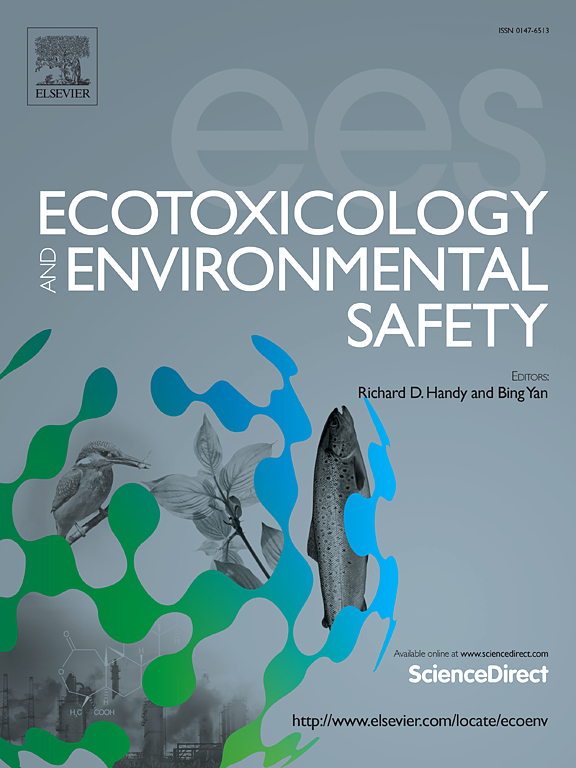Chitosan-oligosaccharide alleviates chlorpyrifos-induced biochemical and developmental toxicity and reduces its accumulation in wheat (Triticum aestivum L.)
IF 6.2
2区 环境科学与生态学
Q1 ENVIRONMENTAL SCIENCES
引用次数: 0
Abstract
Chlorpyrifos (CHP) contamination affects agricultural land and poses significant risks to plants and humans. Chitosan-oligosaccharide (COS) enhances plant resilience under stress and boosts the activity of enzymes metabolizing exogenous substances. This study aimed to explore the potential and mechanism of COS in mitigating CHP phytotoxicity and reducing CHP accumulation through both pot and field experiments. The results indicated that CHP exposure caused oxidative stress and decreased photosynthesis by 18.5 % in wheat. COS up-regulated the expression of antioxidant enzyme genes in CHP-stressed plants, resulting in a 12.1 %-29.4 % increase in antioxidant enzyme activity, which resulted in an 11.3 %-12.8 % reduction in reactive oxygen species (ROS) and an 11.5 %-14.7 % reduction in malondialdehyde (MDA) content in leaves and roots, respectively. Additionally, COS increased chlorophyll content by 6.6 % by regulating genes related to chlorophyll metabolism, enhancing photosynthesis by 13.6 %. COS also reduced CHP uptake and accelerated its metabolism by upregulating CYP450, GST, and lignin biosynthesis-related genes. Wheat treated with COS exhibited a 26.7 %-28.7 % reduction in grains' CHP content, resulting in a lower health risk index (HRI). These findings provide novel insights into the potential of COS in alleviating CHP phytotoxicity and reducing its accumulation.
毒死蜱(CHP)污染影响着农田,对植物和人类构成重大风险。壳聚糖寡糖(COS)可增强植物在胁迫下的恢复能力,并提高代谢外源物质的酶的活性。本研究旨在通过盆栽和田间试验,探讨 COS 在减轻 CHP 植物毒性和减少 CHP 积累方面的潜力和机制。结果表明,接触 CHP 会导致氧化应激,使小麦的光合作用降低 18.5%。COS 上调了 CHP 胁迫植物中抗氧化酶基因的表达,使抗氧化酶活性提高了 12.1%-29.4%,从而使叶片和根部的活性氧(ROS)减少了 11.3%-12.8%,丙二醛(MDA)含量降低了 11.5%-14.7%。此外,COS 通过调节叶绿素代谢相关基因,使叶绿素含量提高了 6.6%,光合作用提高了 13.6%。COS 还能通过上调 CYP450、GST 和木质素生物合成相关基因,减少 CHP 的吸收并加速其代谢。用 COS 处理过的小麦谷粒中的 CHP 含量降低了 26.7%-28.7%,从而降低了健康风险指数(HRI)。这些发现为 COS 在减轻 CHP 植物毒性和减少其积累方面的潜力提供了新的见解。
本文章由计算机程序翻译,如有差异,请以英文原文为准。
求助全文
约1分钟内获得全文
求助全文
来源期刊
CiteScore
12.10
自引率
5.90%
发文量
1234
审稿时长
88 days
期刊介绍:
Ecotoxicology and Environmental Safety is a multi-disciplinary journal that focuses on understanding the exposure and effects of environmental contamination on organisms including human health. The scope of the journal covers three main themes. The topics within these themes, indicated below, include (but are not limited to) the following: Ecotoxicology、Environmental Chemistry、Environmental Safety etc.

 求助内容:
求助内容: 应助结果提醒方式:
应助结果提醒方式:


